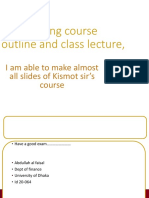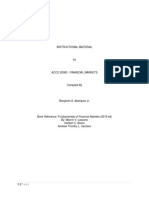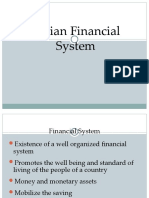0 ratings0% found this document useful (0 votes)
66 viewsFIN 439 Fall 17
FIN 439 Fall 17
Uploaded by
samenThis document outlines a course on financial markets. The course code is FIN 439 and it is worth 3 credit hours. The course aims to examine the nature and functions of domestic and foreign financial markets and how financial institutions and markets are evolving. Key topics covered include money markets, bond markets, stock markets, mortgage markets, foreign exchange markets, and derivatives. Student evaluation will include assignments, presentations, quizzes, a midterm exam, and a final exam. Required textbooks are listed.
Copyright:
© All Rights Reserved
Available Formats
Download as DOC, PDF, TXT or read online from Scribd
FIN 439 Fall 17
FIN 439 Fall 17
Uploaded by
samen0 ratings0% found this document useful (0 votes)
66 views4 pagesThis document outlines a course on financial markets. The course code is FIN 439 and it is worth 3 credit hours. The course aims to examine the nature and functions of domestic and foreign financial markets and how financial institutions and markets are evolving. Key topics covered include money markets, bond markets, stock markets, mortgage markets, foreign exchange markets, and derivatives. Student evaluation will include assignments, presentations, quizzes, a midterm exam, and a final exam. Required textbooks are listed.
Original Title
FIN 439 Fall 17 (1).doc
Copyright
© © All Rights Reserved
Available Formats
DOC, PDF, TXT or read online from Scribd
Share this document
Did you find this document useful?
Is this content inappropriate?
This document outlines a course on financial markets. The course code is FIN 439 and it is worth 3 credit hours. The course aims to examine the nature and functions of domestic and foreign financial markets and how financial institutions and markets are evolving. Key topics covered include money markets, bond markets, stock markets, mortgage markets, foreign exchange markets, and derivatives. Student evaluation will include assignments, presentations, quizzes, a midterm exam, and a final exam. Required textbooks are listed.
Copyright:
© All Rights Reserved
Available Formats
Download as DOC, PDF, TXT or read online from Scribd
Download as doc, pdf, or txt
0 ratings0% found this document useful (0 votes)
66 views4 pagesFIN 439 Fall 17
FIN 439 Fall 17
Uploaded by
samenThis document outlines a course on financial markets. The course code is FIN 439 and it is worth 3 credit hours. The course aims to examine the nature and functions of domestic and foreign financial markets and how financial institutions and markets are evolving. Key topics covered include money markets, bond markets, stock markets, mortgage markets, foreign exchange markets, and derivatives. Student evaluation will include assignments, presentations, quizzes, a midterm exam, and a final exam. Required textbooks are listed.
Copyright:
© All Rights Reserved
Available Formats
Download as DOC, PDF, TXT or read online from Scribd
Download as doc, pdf, or txt
You are on page 1of 4
UNIVERSITY OF GUJRAT
FACULTY OF MANAGEMENT AND ADMINISTRATIVE SCIENCES
I. COURSE INFORMATION
Course Name: Financial Markets
Course Code: FIN 439
Credit Hours: 3
Prerequisite: Financial Management
Class: BBA VII, MBA III
II. COURSE DESCRIPTION
The overall objective of this course is to examine the nature, purpose and economic
functions of financial markets and institutions. The course is important to recognize how
domestic and foreign financial markets are increasingly integrated and that financial
intermediaries are evolving towards a single financial services industry.
III. COURSE OBJECTIVES
At the end of the course the students will be able:
To examine the key characteristics, operations, and regulatory aspects of depository and
non-depository financial institutions, such as commercial banks, securities firms and investment
banks, and insurance companies.
To define the various domestic and foreign financial markets and to describe the special
functions of financial intermediaries.
To understand and recognize the dramatic changes taking place in the financial services
industry, leading to a breakdown in inter industry and inter country barriers.
IV. COURSE OUTCOMES
The following learning outcomes are to be achieved by the end of this course:
Ability to understand the structure of financial Markets.
Ability to examine in depth the various financial markets: participants, securities traded,
and the trading process.
Ability to function as a productive member of a work team.
V. COURSE CONTENTS
Overview of the Financial System
Money Market
Bond Market
Stock Market
Mortgage Market
Foreign Exchange Markets
Derivatives
DETAILED COURSE OUTLINE
Week Topic
1-2 Overview of the Financial System
Function of Financial Markets
Structure of Financial Markets
Toufeeq Brothers
3 Why Do Financial Systems exist
Basic Facts about Financial System
Transaction Cost
Lemon Problem
Financial Panic
Financial markets driving change at company level: Cembre S.p.
4-5 Part II: Debt Market
Money Market
Purpose of Money Markets
Participants in Money Markets
Instruments in Money Markets
Financial markets driving change at company level: Eramet.
6 Bond Market
Purpose of Bond Markets
Participants in Bond Markets
Instruments in Bond Markets
US Junk Bond Bubble: Is History a Better Guide for the Presen
7 Part IV Foreign Exchange Markets
Purpose of FX
Participants
Instruments
8 Mid Terms
9 Mortgage Market
Mortgage
Types of Mortgages
Secondary Mortgage Market (Mortgage Backed Securities)
Leehman Brothers
10-11 Part III: Equity Market
Offering Stock & Monitoring Investor
Purpose of Stock Market Markets
Initial Public Offering
Secondary Stock offering
Investor participation in secondary market
Investor Monitoring & Corporate Monitoring
Barriers to Corporate Control
Stock Market Transactions
How Trades are executed
Deutsche Börse’s Bid for London Stock Exchange: What’s the
Strategic Fit?
12 Part V: Derivative Security Markets.
Purpose
12-13 Participants
Instruments
13 Investment Banks, Security Broker & Dealers, and VC Firms
Investment Banks
Security Brokers and Dealers
Regulations of Securities Firms
Venture Capital Firms
14 The International Financial System
Balance of Payment
Exchange Rate Regimes
15 Presentations
16 Revision
VI. EVALUATION
Assignments: 10%
Presentations: 10%
Quizzes: 5%
Mid Term Examination: 25%
Final Examination: 50%
Total: 100%
VII. REQUIRED TEXTBOOK(S)
Financial Markets and Institutions, by Frederic S. Mishkin and Stanley G. Eakins,
Pearson Hall, Fifth Edition, 2015.
Financial Institutions and Markets, by Madura, Jeff , Seventh Edition, 2015.
You might also like
- Financial Institutions Management A Risk Management Approach 9th Edition Saunders Solutions ManualDocument40 pagesFinancial Institutions Management A Risk Management Approach 9th Edition Saunders Solutions Manualsyeniticbitts2y47j9100% (23)
- Financial Markets and Institutions NotesDocument59 pagesFinancial Markets and Institutions NotesParbon Acharjee100% (3)
- PPTs On Chapters 5-8 of CGDocument42 pagesPPTs On Chapters 5-8 of CGnikhilsharma5No ratings yet
- 2007 Resume Book TuckDocument92 pages2007 Resume Book TuckKang-Li Cheng100% (3)
- FICM Ch-IDocument27 pagesFICM Ch-IGuda GudetaNo ratings yet
- Notes 1Document9 pagesNotes 1Peter MorrisNo ratings yet
- FMI - Class - 1 - 2 - 3 Till 15 - 10Document45 pagesFMI - Class - 1 - 2 - 3 Till 15 - 10CHANDAN SAHOONo ratings yet
- Intro & FS OverviewDocument26 pagesIntro & FS OverviewEkaterina DeevaNo ratings yet
- Fianncial MarketDocument14 pagesFianncial MarketJean Fajardo BadilloNo ratings yet
- SYBCom - Financial Services and Production Management - Module 1Document30 pagesSYBCom - Financial Services and Production Management - Module 1Yash SuranaNo ratings yet
- Chap1 Introduction 94ac847c9ee5d8c92d6cbd13cb447209Document45 pagesChap1 Introduction 94ac847c9ee5d8c92d6cbd13cb447209sajaNo ratings yet
- Chapter 1 - Overview of Financial MarketsDocument11 pagesChapter 1 - Overview of Financial MarketsSwayam Prabha BeheraNo ratings yet
- Financial Markets Sessions 2 2020Document131 pagesFinancial Markets Sessions 2 2020Ridwan IslamNo ratings yet
- Financial Market Instructional Material by Lascano CompressDocument72 pagesFinancial Market Instructional Material by Lascano CompressFiona MiralpesNo ratings yet
- MGT 418Document5 pagesMGT 418Ali Akbar MalikNo ratings yet
- 1.1 Finance and Financial SectorDocument36 pages1.1 Finance and Financial SectorPhanieNo ratings yet
- 1.1 Finance and Financial SectorDocument36 pages1.1 Finance and Financial SectorAki Crush koNo ratings yet
- Financial Markets Instructional Material 1st Sem SY2020 21 Modules 1 To 8 PDFDocument72 pagesFinancial Markets Instructional Material 1st Sem SY2020 21 Modules 1 To 8 PDFLorielyn Mae SalcedoNo ratings yet
- 1618906177FMS PDFDocument44 pages1618906177FMS PDFpragatishrivastava875No ratings yet
- CHAPTER 2.1 Financial System Sv4.0Document24 pagesCHAPTER 2.1 Financial System Sv4.0Linh AhNo ratings yet
- Foi CH 2Document10 pagesFoi CH 2palsakshi1123No ratings yet
- CO PO SAMPLE syllabus-FMIDocument5 pagesCO PO SAMPLE syllabus-FMISonali MoreNo ratings yet
- MMS Financial Markets and Institutions 1Document167 pagesMMS Financial Markets and Institutions 1Sonali MoreNo ratings yet
- Chapter 1 - Introduction & Chapter 4 - Federal Reserve SystemDocument22 pagesChapter 1 - Introduction & Chapter 4 - Federal Reserve SystemAhmed El KhateebNo ratings yet
- Indian Financial System: Course ManualDocument6 pagesIndian Financial System: Course ManualVinod PandaNo ratings yet
- Capital Market - 26830Document89 pagesCapital Market - 26830NamrataShahaniNo ratings yet
- 2 Chapter-Capital MarketDocument17 pages2 Chapter-Capital Marketwasi28No ratings yet
- Course OutlineDocument7 pagesCourse Outlinetirupati phutelaNo ratings yet
- Document 2Document114 pagesDocument 2Jayshreeben DobariyaNo ratings yet
- 3 - Unit I - Introduction To Financial Systems and Financial MarketDocument41 pages3 - Unit I - Introduction To Financial Systems and Financial MarketAlexis Ann Angan AnganNo ratings yet
- CHAPTER 2.1 - Financial System - sv4.1Document25 pagesCHAPTER 2.1 - Financial System - sv4.1k62.2312150207No ratings yet
- WQU Financial Markets Module 1 Compiled Content PDFDocument29 pagesWQU Financial Markets Module 1 Compiled Content PDFJaeN_Programmer67% (3)
- Inancial Ystem: Prof. Manoharan.MDocument10 pagesInancial Ystem: Prof. Manoharan.MKaran NarangNo ratings yet
- Outline Finanical Market and Instituations COMM7503Document1 pageOutline Finanical Market and Instituations COMM7503Syed Ali HaiderNo ratings yet
- IM For Financial Markets 1st Sem SY2020 21 Modules 1 To 8 Rev1Document62 pagesIM For Financial Markets 1st Sem SY2020 21 Modules 1 To 8 Rev1Sky LawrenceNo ratings yet
- A Study of Online Trading and Stock Broking"Document48 pagesA Study of Online Trading and Stock Broking"Prabha100% (1)
- Chapter 1 - Structure of Financial SystemDocument18 pagesChapter 1 - Structure of Financial SystemNur HazirahNo ratings yet
- MSC Financial Markets, Financial Institutions and Banking - IntroductionDocument26 pagesMSC Financial Markets, Financial Institutions and Banking - IntroductionLumumba KuyelaNo ratings yet
- Lecture 1 FmiDocument77 pagesLecture 1 FmimattNo ratings yet
- Banking & Finance: Inter Institute Credit Transfer Course Dr. Anusree PaulDocument39 pagesBanking & Finance: Inter Institute Credit Transfer Course Dr. Anusree Paulwatratkarta4862No ratings yet
- Element OneDocument17 pagesElement OneSena MulugetaNo ratings yet
- Ramakar Jha CBSE FMM I Book Final VersionDocument279 pagesRamakar Jha CBSE FMM I Book Final Versionmilan senNo ratings yet
- Af-302 - Financial Markets and InstitutionsDocument2 pagesAf-302 - Financial Markets and InstitutionsFuadNo ratings yet
- Lecture 1 Financial System and Interest RateDocument44 pagesLecture 1 Financial System and Interest Rate5fq4wjcxdrNo ratings yet
- Introduction of Financial System Structure and ComponentsDocument18 pagesIntroduction of Financial System Structure and ComponentsSyafiqahNo ratings yet
- Types and OF: Money Market and Capital MarketDocument39 pagesTypes and OF: Money Market and Capital MarketDikshita NavaniNo ratings yet
- Law of Corporate FinanceDocument3 pagesLaw of Corporate FinanceAbdul Qadir Juzer Aeranpurewala100% (1)
- OverviewDocument14 pagesOverviewĐức Thành NguyễnNo ratings yet
- Bahir Dar University College of Business & Economics Department of Accounting and Finance MSC Program T-Learning ProcessDocument7 pagesBahir Dar University College of Business & Economics Department of Accounting and Finance MSC Program T-Learning Processyohannes kindalem100% (1)
- Final - SFM - Money Market PDFDocument37 pagesFinal - SFM - Money Market PDFMarikrishna Chandran CANo ratings yet
- FINANCIAL INSTITUTIONS AND CAPITAL MARKETS Course OutlineDocument2 pagesFINANCIAL INSTITUTIONS AND CAPITAL MARKETS Course OutlineAbdifatah Ahmed HurreNo ratings yet
- Indian Securities MarketDocument26 pagesIndian Securities MarketPrasad RNo ratings yet
- Capital MarketsDocument41 pagesCapital Marketssrikwaits4u100% (5)
- Financial ServicesDocument77 pagesFinancial ServicesGiridhara Raju80% (5)
- CH 01Document32 pagesCH 01Rafat ShultanaNo ratings yet
- IPO Word Doc-ParadkarDocument95 pagesIPO Word Doc-Paradkarkiran rokadeNo ratings yet
- Indian Capital Market: Current Scenario & Road Ahead: Prof Mahesh Kumar Amity Business SchoolDocument44 pagesIndian Capital Market: Current Scenario & Road Ahead: Prof Mahesh Kumar Amity Business SchoolasifanisNo ratings yet
- Eae 403 - Financial Economics 2 by Clare GathogaDocument87 pagesEae 403 - Financial Economics 2 by Clare Gathogamiged90235No ratings yet
- Bank Asset and Liability Management: Strategy, Trading, AnalysisFrom EverandBank Asset and Liability Management: Strategy, Trading, AnalysisNo ratings yet
- DoMS Investment Banking Capital Market OperationsDocument2 pagesDoMS Investment Banking Capital Market OperationsKumarNo ratings yet
- School: 0.00 KM To 42.210 KM Public Works Deparment Jalna Length of Road:-Ranjani Kumbharpimpalgaon Rajatakli RoadDocument23 pagesSchool: 0.00 KM To 42.210 KM Public Works Deparment Jalna Length of Road:-Ranjani Kumbharpimpalgaon Rajatakli RoadAbhijeet SahuNo ratings yet
- Daily Derivatives: ICICI Securities LTDDocument3 pagesDaily Derivatives: ICICI Securities LTDRohan KoliNo ratings yet
- CICI Securities LTD Is An Integrated Securities Firm Offering A Wide Range of Services Including Investment BankingDocument5 pagesCICI Securities LTD Is An Integrated Securities Firm Offering A Wide Range of Services Including Investment Bankingsa20004No ratings yet
- JPMorgan Econ FI-China FX Reserves A Touch Above Expectation Two-Sided Risks... - 110660083Document9 pagesJPMorgan Econ FI-China FX Reserves A Touch Above Expectation Two-Sided Risks... - 110660083hyp7409No ratings yet
- Addendum To Real Estate MortgageDocument4 pagesAddendum To Real Estate Mortgagegabriella shintaine dominique dilayNo ratings yet
- Wa0087.Document9 pagesWa0087.Mohammed Israr ShaikhNo ratings yet
- Abstract:: Financial Institutions and Their Role in The Development and Financing of Small Individual ProjectsDocument14 pagesAbstract:: Financial Institutions and Their Role in The Development and Financing of Small Individual ProjectsRamona Georgiana IonițăNo ratings yet
- Bryce StartUp Space 2022Document39 pagesBryce StartUp Space 2022Dmitry PaysonNo ratings yet
- Q1 2023 AcquisitionsDocument28 pagesQ1 2023 AcquisitionsWilliam HarrisNo ratings yet
- Commercial Banking vs. Investment BankingDocument23 pagesCommercial Banking vs. Investment Bankingpranav2411No ratings yet
- Universal Banking in IndiaDocument6 pagesUniversal Banking in IndiaashwanidusadhNo ratings yet
- EMBA Class Directory FINAL LowresDocument12 pagesEMBA Class Directory FINAL Lowresssss1234dNo ratings yet
- Finmar ReviewerDocument15 pagesFinmar Reviewerrozaliemedina09No ratings yet
- API NY - GDP.MKTP - CN DS2 en Excel v2 5872922Document91 pagesAPI NY - GDP.MKTP - CN DS2 en Excel v2 5872922Huỳnh Xuân NhiNo ratings yet
- Datatreasury Corporation v. Wells Fargo & Company Et Al - Document No. 108Document4 pagesDatatreasury Corporation v. Wells Fargo & Company Et Al - Document No. 108Justia.comNo ratings yet
- Goldman Sachs Book ListDocument4 pagesGoldman Sachs Book ListRobertaNo ratings yet
- Graduate Recruitment Programme 2009 A-Z Directory For CDP WebsiteDocument61 pagesGraduate Recruitment Programme 2009 A-Z Directory For CDP WebsiteJoyce KanhemaNo ratings yet
- BC Final ReportDocument50 pagesBC Final Reportvedantrange3032000No ratings yet
- ATS Resume SampleDocument4 pagesATS Resume SampleJoe KingNo ratings yet
- Chapter 1 - Understanding InvestmentsDocument8 pagesChapter 1 - Understanding InvestmentsWaseem Liaquat Khan86% (7)
- Internship Report On SFLDocument22 pagesInternship Report On SFLEhsan OheeNo ratings yet
- Financial Performance of Lakshmi VilasDocument37 pagesFinancial Performance of Lakshmi VilassuganyaNo ratings yet
- CFAB. Commercial Banks - Chapter 5 - Consumer LoansDocument36 pagesCFAB. Commercial Banks - Chapter 5 - Consumer LoansViet Ha HoangNo ratings yet
- Inc. Magazine 2013-11Document144 pagesInc. Magazine 2013-11Juan Pablo DelgadoNo ratings yet
- Investment Banking KnowledgeDocument7 pagesInvestment Banking Knowledge1raju1234100% (1)

























































































